Electrical Properties at Multi-Frequencies for Analysis of Physical and Anatomical Properties of Fast-Growing Standing Teak Trees at Various Ages
Abstract
1. Introduction
2. Materials and Methods
2.1. Site, Tree Selection, and Sampling
2.2. Field Measurement
2.3. Physical and Anatomical Properties Observation
2.4. Data Analysis
3. Results
3.1. Dielectric Characteristics of Fast-Growing Teak
3.2. Physical and Anatomical Properties
3.3. Regression Model Development
4. Discussion
5. Conclusions
Author Contributions
Funding
Data Availability Statement
Acknowledgments
Conflicts of Interest
References
- Corryanti; Muharyani, N. The opportunities and challenges of Jati plus Perhutani. Wood Res. J. 2018, 9, 1–3. [Google Scholar] [CrossRef]
- Rizanti, D.E.; Darmawan, W.; George, B.; Merlin, A.; Dumarcay, S.; Chapuis, H.; Gérardin, C.; Gelhaye, E.; Raharivelomanana, P.; Sari, R.K.; et al. Comparison of teak wood properties according to forest management: Short versus long rotation. Ann. For. Sci. 2018, 75, 39. [Google Scholar] [CrossRef]
- Riantin, N.V.; Wahyudi, I.; Priadi, T. Anatomical structure and physical properties of the 13 years old solomon-clone teakwood planted in Bogor, Indonesia. IOP Conf. Ser. Mater. Sci. Eng. 2020, 935, 012040. [Google Scholar] [CrossRef]
- Adi, D.S.; Himmi, S.K.; Sudarmanto; Amin, Y.; Darmawan, T.; Dwianto, W. Radial variation of wood properties of eight years-old fast-growing teak (Tectona grandis—Platinum teak wood). IOP Conf. Ser. Earth Environ. Sci. 2020, 591, 012035. [Google Scholar] [CrossRef]
- Basri, E.; Wahyudi, I. Wood basic properties of Jati plus Perhutani from different ages and their relationships to drying properties and qualities. J. Penelit. Has. Hutan 2013, 31, 93–102. [Google Scholar] [CrossRef]
- Hidayati, F.; Sulistyo, J.; Lukmandaru, G.; Listyanto, T.; Praptoyo, H.; Pujiarti, R. Physical and mechanical properties of 10-year-old superior and conventional teak planted in Randublatung Central Java Indonesia. J. Ilmu Teknol. Kayu Trop. 2015, 13, 11–21. [Google Scholar]
- Listyanto, T.; Yudhana, F.; Putera, H.P.; Purwanta, S.; Lukmandaru, G.; Sulistyo, J.; Marsoem, S.N. Physical properties and natural durability of fast-growing teak at 12 years-old against subterranean and drywood termites. In Proceedings of the 9th International Symposium of Indonesia Wood Research Society (IWoRS), Bali, Indonesia, 26–29 September 2017; pp. 144–152. [Google Scholar]
- Nicolotti, G.; Socco, L.V.; Martinis, R.; Godio, A.; Sambuelli, L. Application and comparison of three tomographic techiques for detection decay in trees. J. Arboric. 2003, 29, 66–78. [Google Scholar]
- Wang, H.; Liu, Y.; Wei, Y.; Wu, C.K.; Zhu, H.; Tsang, K.F. NB-IoT based tree health monitoring system. In Proceedings of the 2019 IEEE International Conference on Industrial Technology (ICIT), Melbourne, VIC, Australia, 13–15 February 2019; pp. 1796–1799. [Google Scholar]
- Karlinasari, L.; Adzkia, U.; Puspitasari, T.; Nandika, D.; Nugroho, N.; Syafitri, U.D.; Siregar, I.Z. Tree morphometric relationships and dynamic elasticity properties in tropical rain tree (Samanea saman Jacq. Merr). Forests 2021, 12, 1711. [Google Scholar] [CrossRef]
- Martiansyah, I.; Zulkarnaen, R.N.; Hariri, M.R.; Hutabarat, P.W.K.; Wardani, F.F. Tree health monitoring of risky trees in the hotel open space: A case study in Rancamaya, Bogor. J. Sylva Lestari 2022, 10, 180–201. [Google Scholar] [CrossRef]
- Meng, X.; Zheng, Y.; Liu, W. Development of non-destructive testing device for plant leaf expansion monitoring. Electronics 2023, 12, 249. [Google Scholar] [CrossRef]
- Wu, Y.; Yang, Z.; Liu, Y. A non-destructive measurement of trunk moisture content in living trees based on multi-sensory data fusion. Appl. Sci. 2023, 13, 6990. [Google Scholar] [CrossRef]
- Du Toit, F.; Coops, N.C.; Ratcliffe, B.; El-Kassaby, Y.A.; Lucieer, A. Modelling internal tree attributes for breeding in applications in douglas-fir progeny trials using RPAS-ALS. Sci. Remote Sens. 2023, 7, 100072. [Google Scholar] [CrossRef]
- Karlinasari, L.; Danu, M.I.; Nandika, D.; Turjaman, M. Drilling resistance method to evacuate density and hardness properties of resinous wood of agarwood (Aquilaria malaccensis). Wood Res. 2017, 62, 683–690. [Google Scholar]
- Esofita, M.; Djamal, M.; Taruno, W.P.; Al Huda, M.; Baidillah, M.; Pari, G.; Damayanti, R. Analysis of wood’s capacitance characteristic to its hardness. Appl. Mech. Mater. 2015, 771, 161–164. [Google Scholar] [CrossRef]
- Oktapiani, C.; Damayanti, R.; Karlinasari, L.; Agustiningrum, D.A.; Pari, R.; Djarwanto; Rahmanto, R.G.H.; Sofianto, I.A.; Dewi, L.M. The effect of anatomical structure on hygroscopicity of four wood species. In Proceedings of the 14th International Symposium of IWoRS, Jatinangor, Bandung, Indonesia, 3–4 August 2022. [Google Scholar]
- Fridh, L.; Eliasson, L.; Bergström, D. Precision and accuracy in moisture content determination of wood fuel chips using a handheld electric capacitance moisture meter. Silva Fenn. 2018, 52, 6993. [Google Scholar] [CrossRef]
- Lev, J.; Křepčík, V.; Šarauskis, E.; Kumhála, F. Electrical capacitance characteristics of wood chips at low frequency ranges: A cheap tool for quality assessment. Sensors 2021, 21, 3494. [Google Scholar] [CrossRef] [PubMed]
- Mačiulaitis, R.; Jefimovas, A.; Lipinskas, D. Research on the electrical capacitance and electrical conductivity of char resulting from natural and treated wood. J. Civ. Eng. Manag. 2014, 21, 11–20. [Google Scholar] [CrossRef]
- Dietsch, P.; Franke, S.; Franke, B.; Gamper, A.; Winter, S. Methods to determine wood moisture content and their applicability in monitoring concepts. J. Civ. Struct. Health Monit. 2014, 5, 115–127. [Google Scholar] [CrossRef]
- Husein, I.; Sadiyo, S.; Nugroho, N.; Wahyudi, I.; Agustina, A.; Komariah, R.N.; Khabibi, J.; Purba, C.Y.C.; Ali, D.; Iftor, M.; et al. Electrical properties of indonesian hardwood case study: Acacia mangium, Swietenia macrophylla and Maesopsis eminii. Wood Res. 2014, 59, 695–704. [Google Scholar]
- Jamayani, E.; Rahman, M.R.; Hamdan, S.; Kyari, M.I.; Bakri, M.K.B.; Sanaullah, K.; Khan, A. Dielectric properties of natural borneo woods: Keranji, kayu malam, and kumpang. BioResources 2020, 15, 7815–7827. [Google Scholar] [CrossRef]
- El-Hadad, A.; Brodie, G.; Ahmed, B. The effect of wood condition on sound wave propagation. Open J. Acoust. 2018, 8, 37–51. [Google Scholar] [CrossRef][Green Version]
- Venkatesh, M.S.; Raghavan, G.S.V. An overview of microwave processing and dielectric properties of agri-food materials. Biosys. Eng. 2004, 88, 1–18. [Google Scholar] [CrossRef]
- Skierucha, W.; Wilczek, A.; Szypłowska, A. Dielectric spectroscopy in agrophysics. Int. Agrophys. 2012, 26, 187–197. [Google Scholar] [CrossRef]
- Khaled, D.E.; Castellano, N.N.; Gázquez, J.A.; Perea-Moreno, A.-J.; Manzano-Agugliaro, F. Dielectric spectroscopy in biomaterials: Agrophysics. Materials 2016, 3, 310. [Google Scholar] [CrossRef] [PubMed]
- Deshmukh, K.; Sankaran, S.; Ahamed, B.; Sadasivuni, K.K.; Pasha, K.S.K.; Ponnama, D.; Sreekanth, P.S.R.; Chidambaram, K. Dielectric spectroscopy. In Spectroscopic Methods for Nanomaterials Characterization; Elsevier: Amsterdam, The Netherlands, 2017; pp. 237–299. [Google Scholar]
- Leitzke, J.P.; Zangl, H. A review on electrical impedance tomography spectroscopy. Sensors 2020, 20, 5160. [Google Scholar] [CrossRef]
- Nogales, R.E.; Benalcázar, M.E. Analysis and evaluation of feature selection and feature extraction methods. Int. J. Comput. Intell. Syst. 2023, 16, 153. [Google Scholar] [CrossRef]
- Abellan-Nebot, J.V.; Subirón, F.R. A review of machining monitoring systems based on artificial intelligence process models. Int. J. Adv. Manuf. Technol. 2010, 47, 237–257. [Google Scholar] [CrossRef]
- Blokland, J.; Nasir, V.; Cool, J.; Avramidis, S.; Adamopoulos, S. Machine learning-based prediction of surface checks and bending properties in weathered thermally modified timber. Constr. Build. Mater. 2021, 307, 124996. [Google Scholar] [CrossRef]
- Sun, P. Wood quality defect detection based on deep learning and multicriteria framework. Math. Probl. Eng. 2022, 2022, 4878090. [Google Scholar] [CrossRef]
- EN 14774-1:2009; Solid Biofuels—Determination of Moisture Content—Oven Dry Method—Part 1: Total Moisture—Reference Method. Swedish Standards Institute: Stockholm, Sweden, 2009. Available online: https://www.sis.se/api/document/preview/71672/ (accessed on 5 September 2023).
- Shmulsky, R.; Jones, P.D. Forest Products and Wood Science: An Introduction, 6th ed.; John Wiley & Sons, Inc.: Hoboken, NJ, USA, 2019; pp. 154–196. [Google Scholar]
- Wheleer, E.A.; Baas, P.; Gasson, P.C. IAWA List of Microscopic Features for Hardwood Identification; IAWA Bulletin: Leiden, The Netherlands, 1990. [Google Scholar]
- Ellingson, S.W. Electromagnetics I: Virginia Tech: LibreTexts. Available online: https://phys.libretexts.org/Bookshelves/Electricity_and_Magnetism/Electromagnetics_I_(Ellingson) (accessed on 15 December 2023).
- Simpson, W.T. Specific Gravity, Moisture Content, and Density Relationship for Wood; General Technical Report FPL-GTR-76; U.S. Department of Agriculture, Forest Service, Forest Products Laboratory: Madison, WI, USA, 1993; pp. 1–13. [Google Scholar]
- Simanjuntak, T. Measurement of Dielectric Properties Values of Pepper (Piper nigrum L.) and Andaliman (Zanthoxylum acanthopodium DC.) in the Radio Frequency Range. Master’s Thesis, IPB University, Bogor, Indonesia, 2002. [Google Scholar]
- Tiitta, M.; Kainulainen, P.; Harju, A.M.; Venäläinen, M.; Manninen, A.-M.; Vuorinen, M.; Viitanen, H. Comparing the effect of chemical and physical properties on complex electrical impedance of scots pine wood. Holzforschung 2003, 57, 433–439. [Google Scholar] [CrossRef]

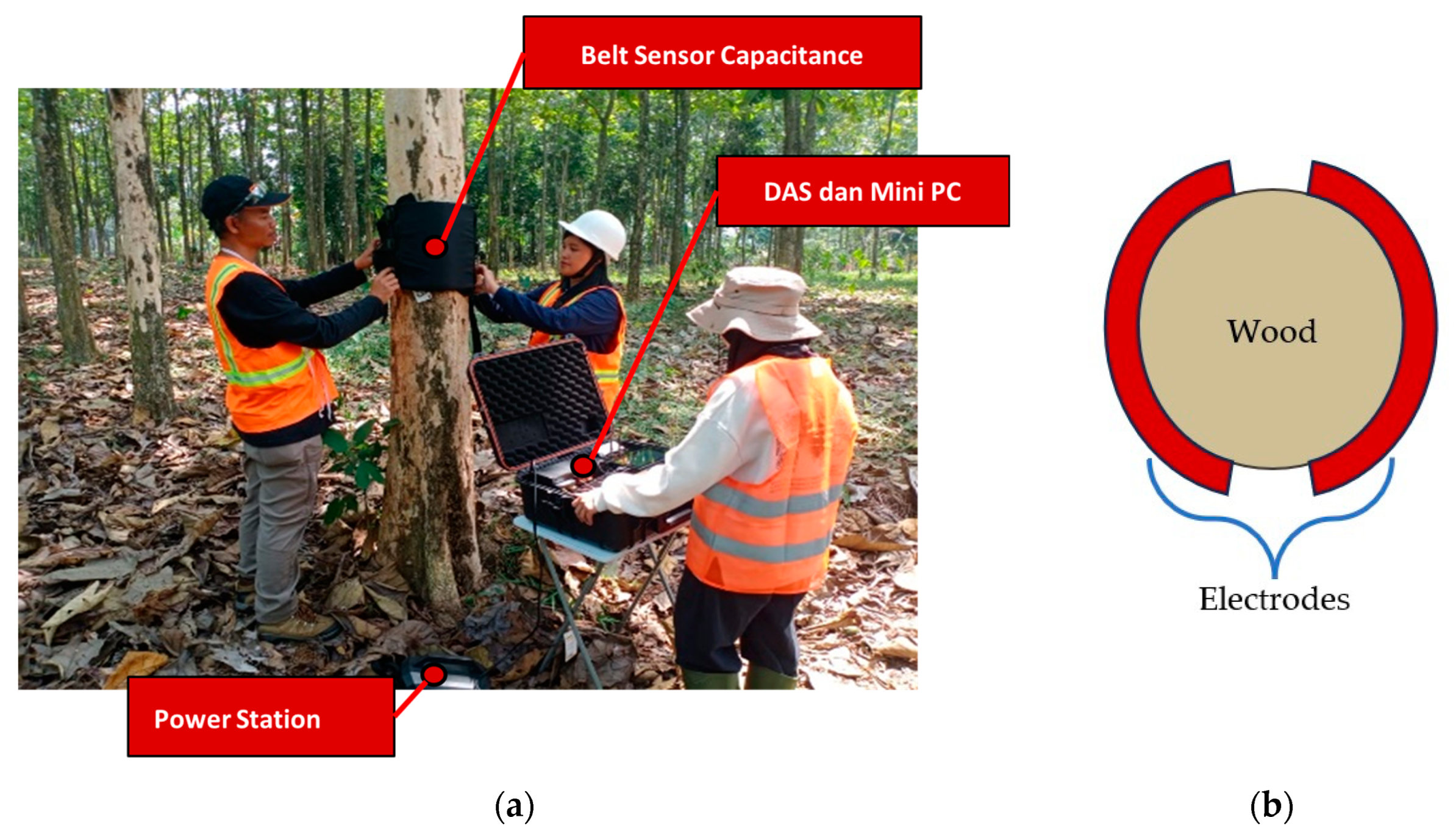
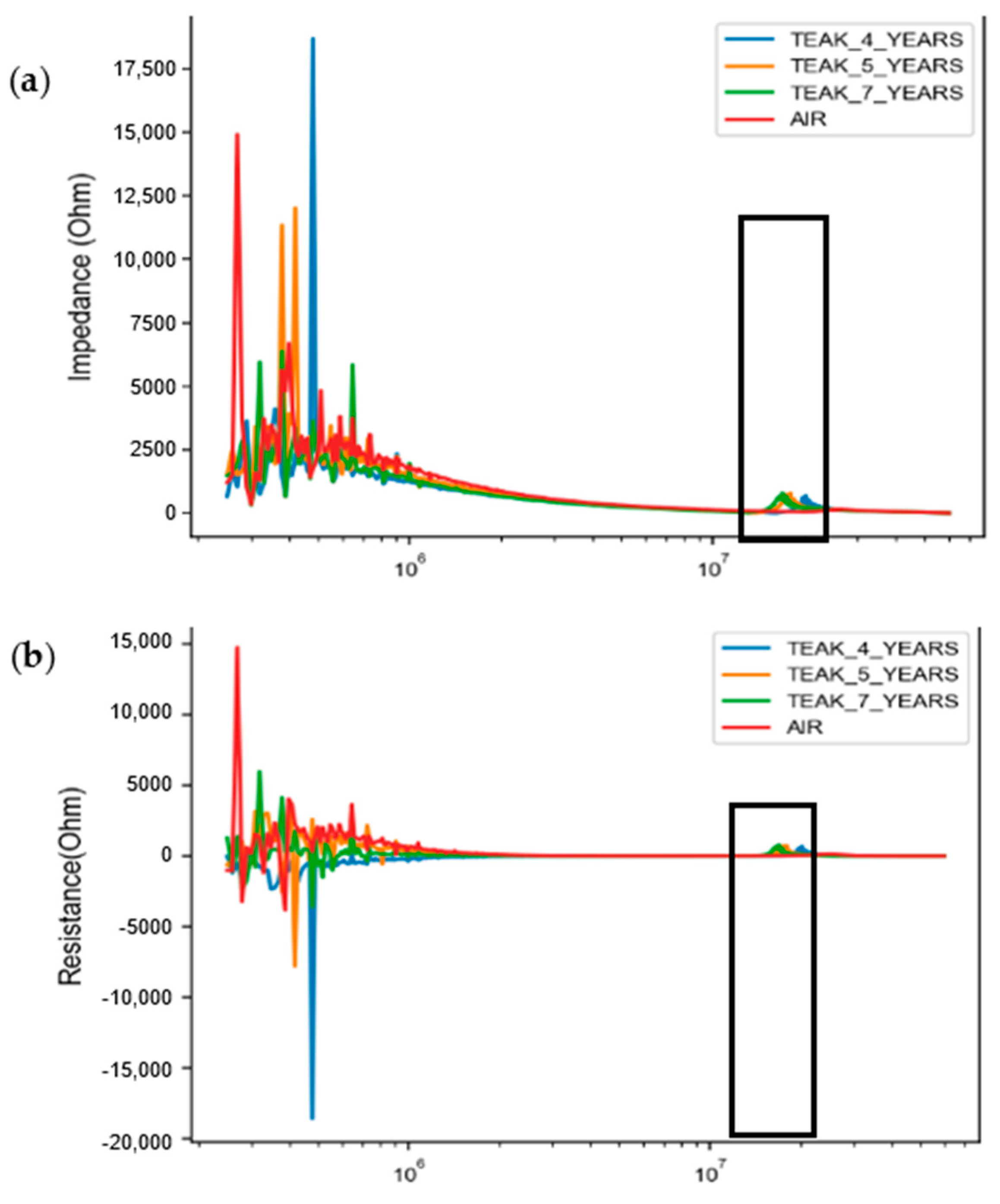
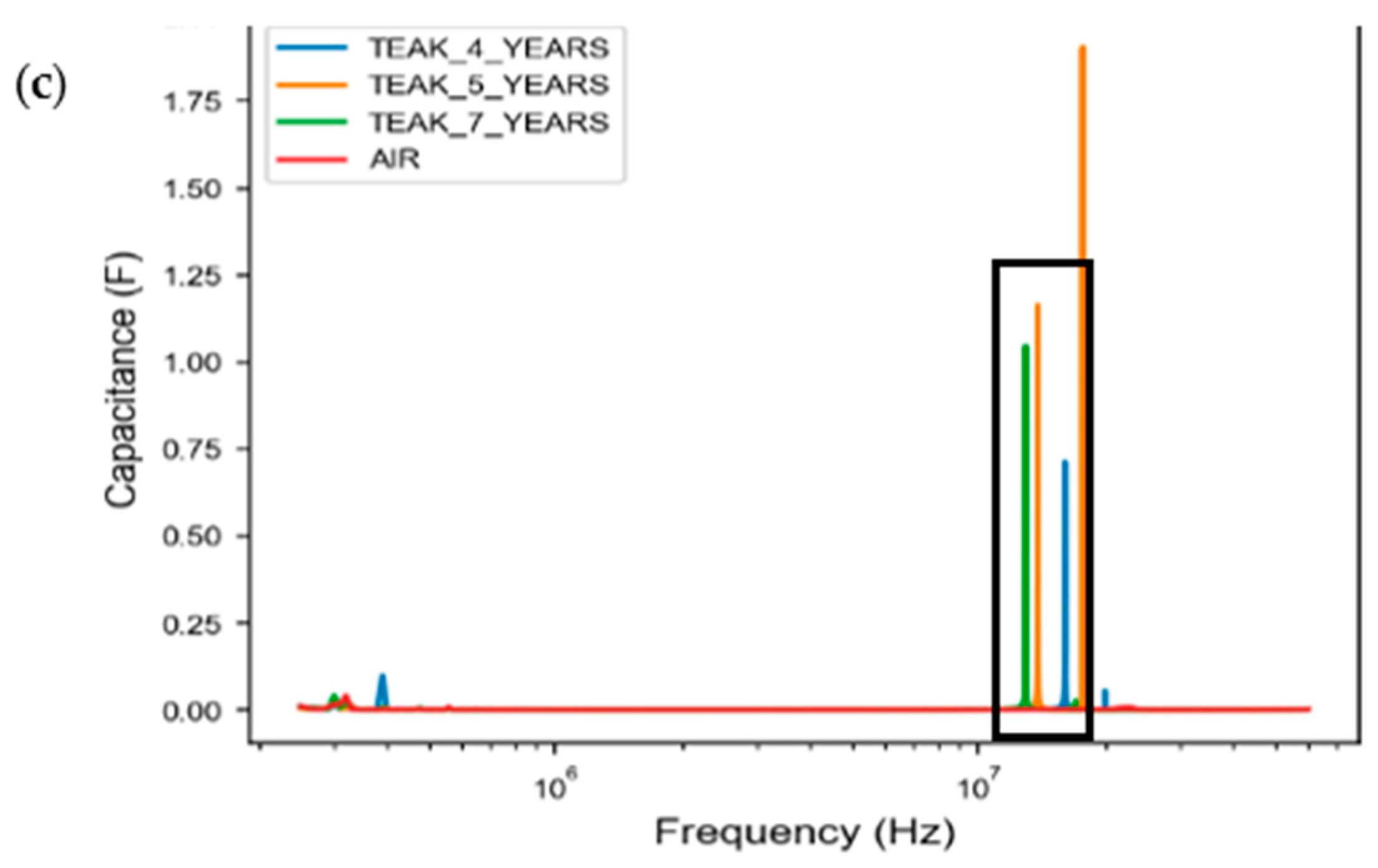
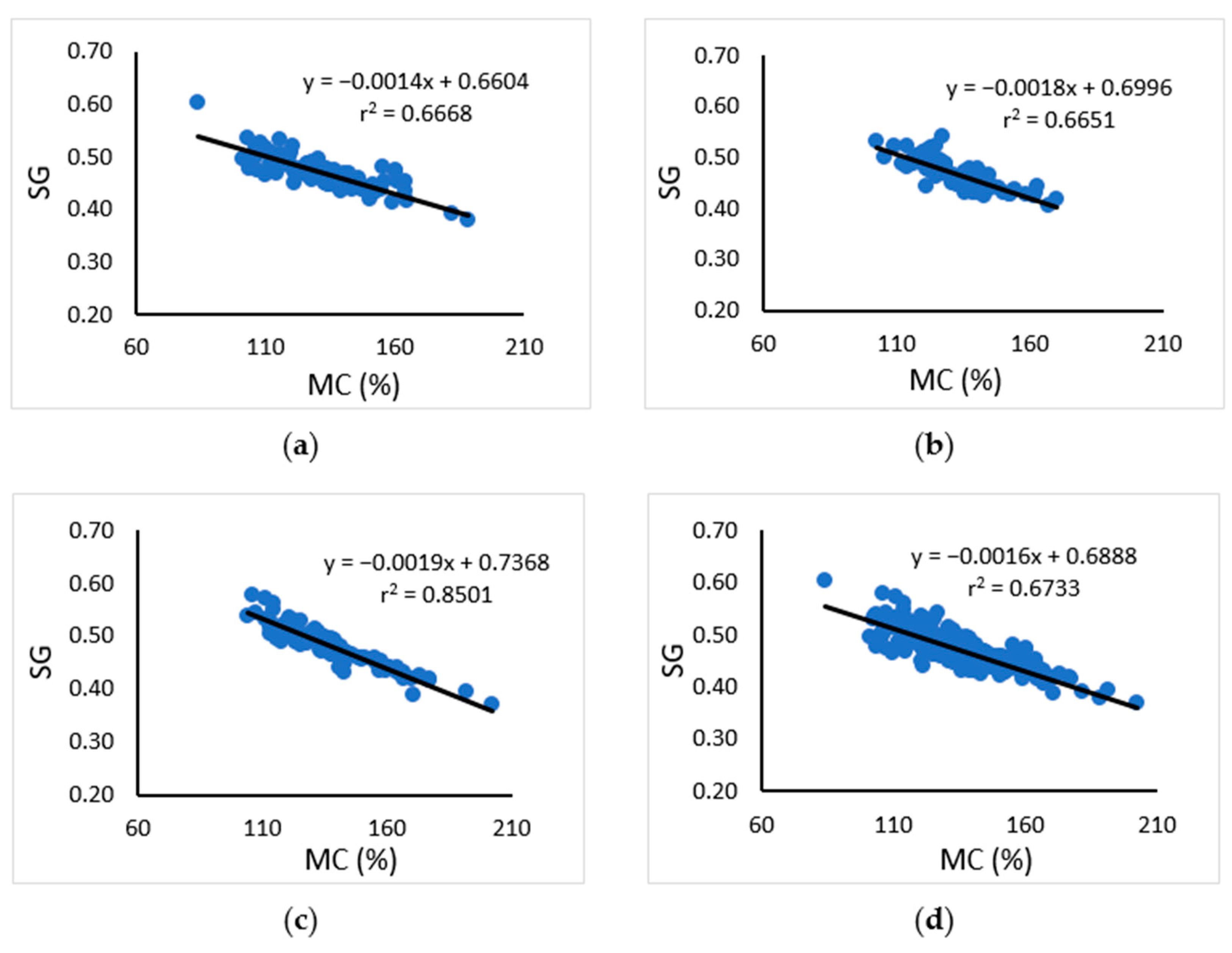
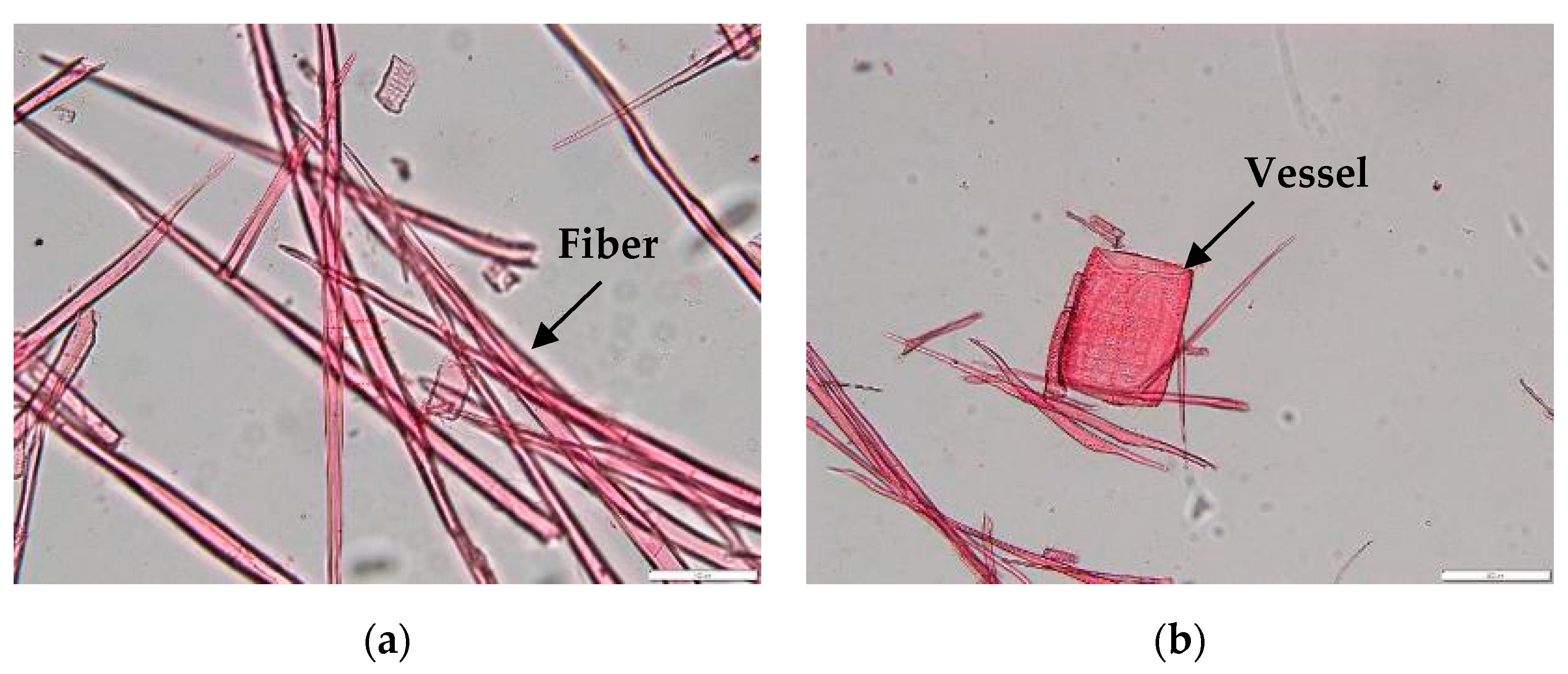
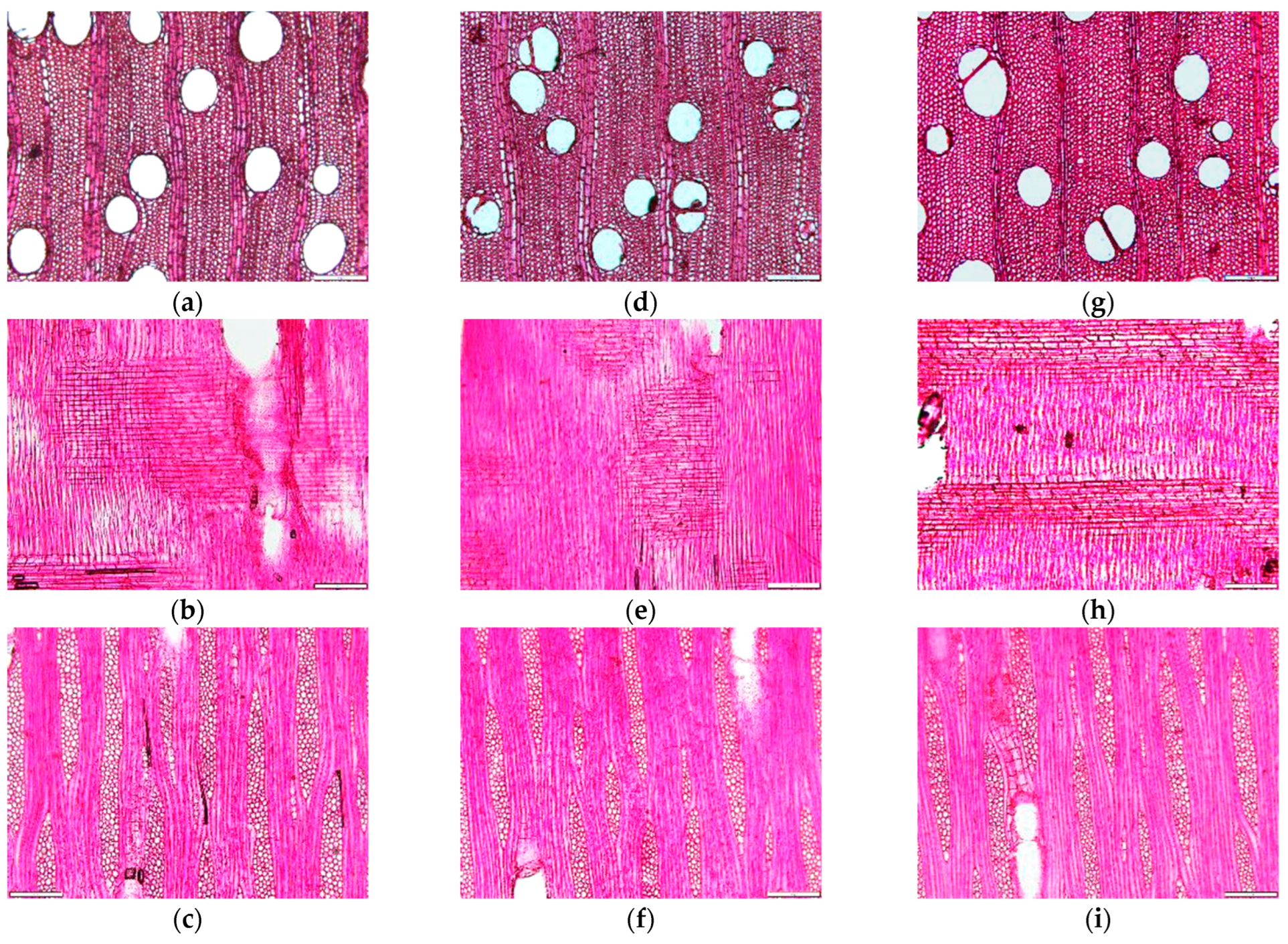
| Year of Planting | Tree Age | RPH | Plot Number | Plot Name | Village | Coordinates |
|---|---|---|---|---|---|---|
| 2019 | 4 years | Jagabaya | 43A-2 | Plot 19-A Plot 19-B Plot 19-C | Jagabaya | Lat. 6°23′8.95″ S–6°23′18.27″ S Long. 106°31′20.03″ E–106°31′27.10″ E |
| 2018 | 5 years | Maribaya | 31A-1 | Plot 18-A Plot 18-B Plot 18-C | Barengkok | Lat. 6°25′49.82″ S–6°28′58.28″ S Long. 106°28′52.53″ E–106°29′7.46″ E |
| 2016 | 7 years | Maribaya | 23B-1 | Plot 16-A Plot 16-B Plot 16-C | Barengkok | Lat. 6°25′53.61″ S–6°25′54.91″ S Long. 106°28′52.53″ E–106°29′8.66″ E |
| Tree Age | Frequency Containing Peak | ||
|---|---|---|---|
| Z | R | C | |
| 4 years | 23 MHz | 23 MHz | 20 MHz |
| 5 years | 21 MHz | 21 MHz | 19 MHz |
| 7 years | 18 MHz | 18 MHz | 18 MHz |
| Tree Age | DBH (cm) | MC (%) | GD (gr/cm3) | SG |
|---|---|---|---|---|
| 4 years | 12.463 | 132.908 a | 1.078 a | 0.465 a |
| 5 years | 13.953 | 133.881 a | 1.084 a | 0.465 a |
| 7 years | 21.317 | 138.360 a | 1.134 a | 0.479 a |
| Tree Age | FL | FD | LD | FWT | VL | VD |
|---|---|---|---|---|---|---|
| 4 years | 1329.38 a | 24.69 a | 11.49 a | 5.41 a | 287.12 a | 161.22 a |
| 5 years | 1270.24 ab | 24.00 a | 12.52 a | 5.93 b | 289.27 a | 178.54 a |
| 7 years | 1483.18 b | 23.16 a | 11.14 b | 6.04 b | 291.05 a | 168.89 a |
| Variable | Model | r | r2 | Adj. r2 | F-Ratio | Sig. |
|---|---|---|---|---|---|---|
| GD | GD = 0.997 + 0.001 MC + 0.021 Z23M − 0.044 C20M | 0.403 | 0.162 | 0.115 | 12.596 | 0.000 |
| SG | SG = 0.696 − 0.002 MC − 0.06 Z21M + 0.010 Z23M − 0.006 R23M − 0.019 C20M | 0.826 | 0.682 | 0.676 | 94.334 | 0.000 |
| FL | FL = 1220.419 + 0.419 MC − 56.750 Z21M + 128.039 R18M − 80.542 C18M − 0.019 C19M | 0.157 | 0.025 | 0.006 | 1.328 | 0.253 |
| FD | FD = 27.021 − 0.027 MC + 1.752 Z23M − 1.197 R21M − 1.064 C18M − 1.095 C19M | 0.163 | 0.027 | 0.005 | 1.174 | 0.320 |
| LD | LD = 12.214 − 0.013 MC + 1.154 Z18M − 1.493 R21M + 2.663 R23M + 1.156 C19M | 0.178 | 0.032 | 0.015 | 1.797 | 0.130 |
| FWT | FWT = 7.019 − 0.007 MC − 0.564 Z18M + 0.744 Z21M + 1.071 R18M − 1.408 C18M − 0.957 C19M | 0.209 | 0.044 | 0.022 | 2.009 | 0.065 |
| VD | VD = 139.843 + 37.449 MC + 37.768 Z21M − 55.786 Z23M + 55.505 R21M + 44.834 R23M | 0.217 | 0.047 | 0.029 | 2.604 | 0.026 |
| VL | VL = 337.448 − 0.290 MC − 53.424 Z18M + 54.630 C18M + 22.411 C19M − 34.574 C20M | 0.175 | 0.031 | 0.012 | 1.672 | 0.142 |
Disclaimer/Publisher’s Note: The statements, opinions and data contained in all publications are solely those of the individual author(s) and contributor(s) and not of MDPI and/or the editor(s). MDPI and/or the editor(s) disclaim responsibility for any injury to people or property resulting from any ideas, methods, instructions or products referred to in the content. |
© 2024 by the authors. Licensee MDPI, Basel, Switzerland. This article is an open access article distributed under the terms and conditions of the Creative Commons Attribution (CC BY) license (https://creativecommons.org/licenses/by/4.0/).
Share and Cite
Agustiningrum, D.A.; Siregar, I.Z.; Damayanti, R.; Taruno, W.P.; Nugraha, H.; Rohmadi; Karlinasari, L. Electrical Properties at Multi-Frequencies for Analysis of Physical and Anatomical Properties of Fast-Growing Standing Teak Trees at Various Ages. Forests 2024, 15, 669. https://doi.org/10.3390/f15040669
Agustiningrum DA, Siregar IZ, Damayanti R, Taruno WP, Nugraha H, Rohmadi, Karlinasari L. Electrical Properties at Multi-Frequencies for Analysis of Physical and Anatomical Properties of Fast-Growing Standing Teak Trees at Various Ages. Forests. 2024; 15(4):669. https://doi.org/10.3390/f15040669
Chicago/Turabian StyleAgustiningrum, Dyah Ayu, Iskandar Zulkarnaen Siregar, Ratih Damayanti, Warsito Purwo Taruno, Harisma Nugraha, Rohmadi, and Lina Karlinasari. 2024. "Electrical Properties at Multi-Frequencies for Analysis of Physical and Anatomical Properties of Fast-Growing Standing Teak Trees at Various Ages" Forests 15, no. 4: 669. https://doi.org/10.3390/f15040669
APA StyleAgustiningrum, D. A., Siregar, I. Z., Damayanti, R., Taruno, W. P., Nugraha, H., Rohmadi, & Karlinasari, L. (2024). Electrical Properties at Multi-Frequencies for Analysis of Physical and Anatomical Properties of Fast-Growing Standing Teak Trees at Various Ages. Forests, 15(4), 669. https://doi.org/10.3390/f15040669









